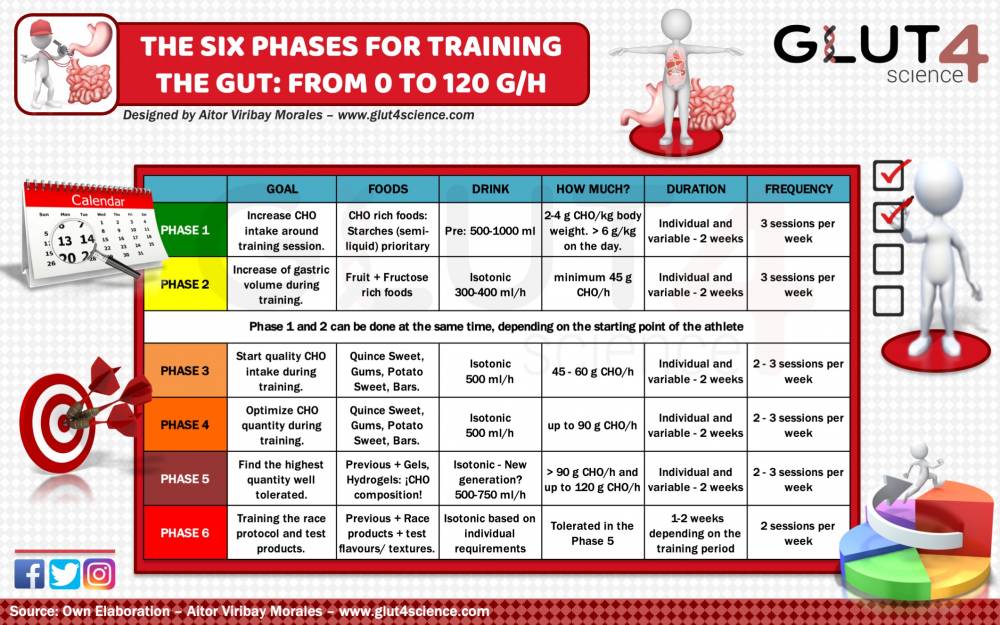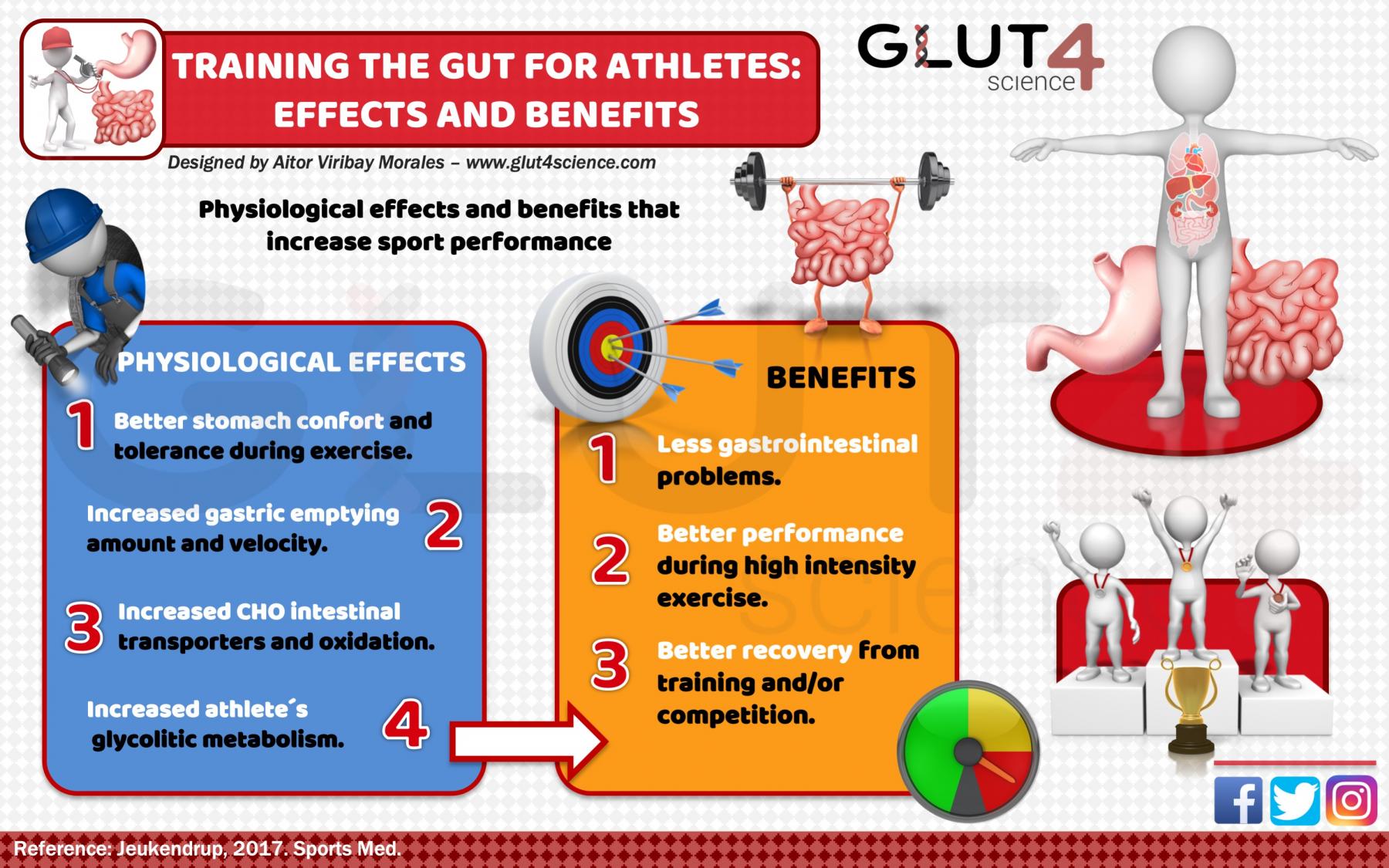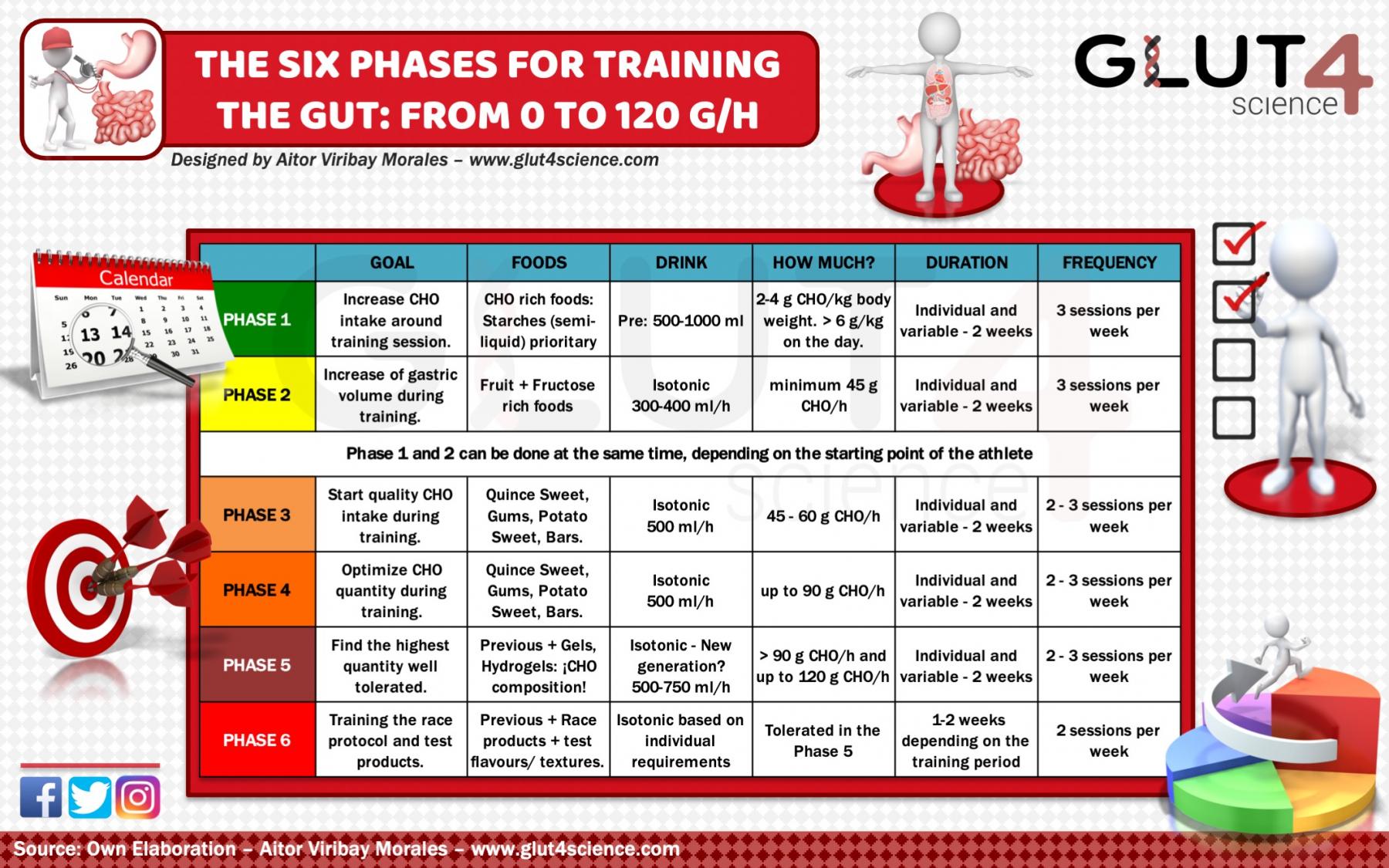The Six Phases for Training the Gut: From 0 to 120 g/h Carbohydrates

120 grams of Carbohydrates per hour, is it possible?
Which is the definitive carbohydrate (CHO) intake target during endurance exercise like cycling or running? Could 120 g/h intake be possible and beneficial comparing with the current scientific recommendations of 60-90 g/h? Is science far behind the sports practice reality?
This is the main question that is already being answered in the scientific literature. As I discuss with Asker Jeukendrup in this post (click here to see), we know really well that it is possible to ingest more than 90 g CHO/h in endurance sport disciplines like trail running or cycling. In fact, we know that besides being possible, it could also be likely beneficial to optimize performance and recovery. As I´ve said before, I´m seeing it on my everyday work with the professional cyclists I advise to. Moreover, considering that last year´s big races were won with higher CHO intakes than 90 g/h (Giro de Italia, Hawaii IronMan, Tour de France), the topic reaches a higher interest. In this sense, it´s clear and well understood among the professionals that work on the field that, in an elite category, higher CHO intakes than currently recommended are needed to win the best races, at least in those critical moments where races like Tour the France are decided.
These observations are mainly based on the fieldwork that we are currently doing, but, as researchers and scientifically-minded professionals, we needed to pose the following question: is there any scientific evidence?
As we have been working these methodologies for some years with professional cyclists and trail runners, we aimed to investigate the effects of a higher CHO intake (up to 120 g/h) in a randomized and well-designed trial. With this in mind, we organized a mountain marathon for 26 elite runners that consumed different CHO doses and measured some performance, neuromuscular function, glycolytic capacity, exercise-induced muscle damage, and recovery variables (blood biomarkers, metabolites and performance tests). This research finally led to a recently published paper that showed beneficial effects on muscle damage biomarkers and internal load during exercise in the 120 g/h group, when compared with 90 g/h and 60 g/h after running the mountain marathon. Moreover, we have finished a second article that is currently under review in the same Q1 journal, regarding neuromuscular function and glycolytic capacity. I hope to be published soon.
The full paper can be read here: Viribay A, Arribalzaga S, Mielgo-Ayuso J, Castañeda-Babarro A, Seco-Calvo J, Urdampilleta A. Effects of 120 g/h of Carbohydrate Intake during a Mountain Marathon on Exercise-Induced Muscle Damage in Elite Runners. Nutrients. 2020; 12(5): 1367.
Independently of these positive results, the main question that has been proposed in the field is how to reach such a high CHO intake without reporting gastrointestinal problems.
In this line, I´ve been working for 3 years in Training the Gut method (a post can be read here) and, thus, I can say quite convinced that, as reported also in the scientific literature, ingesting 120 g/h is possible (and beneficial) after completing a hard training process of the stomach and small intestine.
In fact, this is because the Training the Gut method is based, specifically, on training the digestive system in order to generate adaptations for tolerating higher fluid, volume, and CHO intakes, increasing gastric emptying, transport, and absorption and, possibly, optimizing glycolytic capacity. This training method, including the right selection and combination of the CHO sources, can allow the athletes to ingest more than 90 g CHO/h during exercise with likely beneficial results.
 Physiological effects and benefits of Training the Gut method - Viribay A - Glut4science.
Physiological effects and benefits of Training the Gut method - Viribay A - Glut4science.
Briefly, Training the Gut is a complex method that should be done in a progressive way and based always on the athlete´s feedback. Here I proposed the six phases for Training the Gut method, starting from 0 and finishing with the achievement of the main goal: optimizing CHO intake (up to 120 g/h) and performance during exercise.
In the infographic below I show the six phases that I estimate crucial to increase the tolerance and adaptation to higher CHO intakes. The first ones are proposed to improve the capacity to tolerate higher fluid and CHO ingestion around (before and post) and during the exercise. For this second purpose (during exercise), fruits and fructose-rich foods can be used, together with enough fluid (isotonic drink). The following ones (phases 3 and 4) introduce the CHO intake during exercise in a progressive way (starting from 0-40 g/h and reaching up to 90 g/h) with easy foods like gums, quince sweet, and sweet-potato sweet, for example. In addition, the hydration shouldn´t be set aside during this point of the process. The last phases are designed to reach the individual maximum tolerated CHO amount without reporting GI problems and, finally, to test the race or competition protocols.

With this method based on the completion of progressive phases, a 120 gCHO/h intake can be successfully reached and, as a consequence, also an improved exercise performance and recovery (need to be understood in a specific context). Although this method is based on my work experience, my own investigations, and published articles, more scientific studies are needed to understand the effects of Training the Gut and its effects on the digestive system function. Anyway, this is an awesome starting point, isn´t it?
I hope you find this information useful and interesting. If it´s like this, you can comment on this publication in the site below. Moreover, if you have any questions, please let me know!
If you are interested in learning more about Training the Gut methodology, click here.
If you want to be updated with my latest publications, you can subscribe here to my list.
References:
- Viribay A, Arribalzaga S, Mielgo-Ayuso J, Castañeda-Babarro A, Seco-Calvo J, Urdampilleta A. Effects of 120 g/h of Carbohydrate Intake during a Mountain Marathon on Exercise-Induced Muscle Damage in Elite Runners. Nutrients. 2020; 12(5): 1367.
- Jeukendrup A. Training the gut for athletes. Sports Med. 2017; 47(1): 101-110.
Related Posts:
Comentarios (0 comentarios)
Este artículo no tiene comentarios

